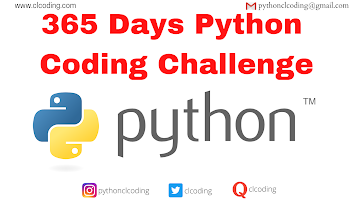Tuesday, 24 October 2023
Monday, 23 October 2023
Python Coding challenge - Day 48 | What is the output of the following Python code?
Python Coding October 23, 2023 Python No comments
.png)
Crash Course on Python (From google)
Python Coding October 23, 2023 Python No comments

Information Extraction from Free Text Data in Health (Free Project)
Python Coding October 23, 2023 Python No comments

Sunday, 22 October 2023
Python Coding challenge - Day 47 | What is the output of the following Python code?
Python Coding October 22, 2023 Python No comments
.png)
Perform exploratory data analysis on retail data with Python (Free Project)
Python Coding October 22, 2023 Python No comments

Create a funnel chart using Matplotlib
Python Coding October 22, 2023 Python No comments

Saturday, 21 October 2023
Python Coding challenge - Day 46 | What is the output of the following Python code?
Python Coding October 21, 2023 Python No comments
.png)
Django for Everybody Specialization
Python Coding October 21, 2023 Django No comments

Top 7 Python courses for developers on Coursera
Python Coding October 21, 2023 Python No comments

Friday, 20 October 2023
Thursday, 19 October 2023
Google Data Analytics Professional Certificate
Python Coding October 19, 2023 Python No comments

Python Coding challenge - Day 44 | What is the output of the following Python code?
Python Coding October 19, 2023 Python No comments
Data Analytics for Lean Six Sigma (Free Course) from Coursera
Python Coding October 19, 2023 Python No comments
Data Visualization with Python (Free Course)
Python Coding October 19, 2023 Python No comments

Wednesday, 18 October 2023
Python Coding challenge - Day 43 | What is the output of the following Python code?
Python Coding October 18, 2023 Python No comments
.png)
MITx: Introduction to Computer Science and Programming Using Python (Free Course)
Python Coding October 18, 2023 Python No comments

Tuesday, 17 October 2023
Python Coding challenge - Day 42 | What is the output of the following Python code?
Python Coding October 17, 2023 Python No comments
Introduction to Python (Free Course)
Python Coding October 17, 2023 Python No comments
.PNG)
Monday, 16 October 2023
Python Coding challenge - Day 41 | What is the output of the following Python code?
Python Coding October 16, 2023 Python No comments
Data Science Math Skills (Free Course)
Python Coding October 16, 2023 Python No comments

Sunday, 15 October 2023
Python Coding challenge - Day 40 | What is the output of the following Python code?
Python Coding October 15, 2023 Python No comments
.png)
Learn Python in One Day and Learn It Well Python for Beginners with Hands-on Project The only book you need to start coding in Python immediately (Second Edition) By Jamie Chan (Free PDF)
Python Coding October 15, 2023 Books, Python No comments

Learning Python: Learn to code like a professional with Python - an open source, versatile, and powerful programming language
Python Coding October 15, 2023 Books, Python No comments

Saturday, 14 October 2023
Python Coding challenge - Day 39 | What is the output of the following Python code?
Python Coding October 14, 2023 Python No comments
.png)
IBM Data Analyst Professional Certificate
Python Coding October 14, 2023 Data Science No comments

Friday, 13 October 2023
Python Coding challenge - Day 38 | What is the output of the following Python code?
Python Coding October 13, 2023 Python No comments
.png)
Cybersecurity for Everyone (Free Course)
Python Coding October 13, 2023 Cybersecurity No comments

Thursday, 12 October 2023
Python Coding challenge - Day 37 | What is the output of the following Python code?
Python Coding October 12, 2023 Python No comments
.png)
Using Databases with Python
Python Coding October 12, 2023 Python No comments

Wednesday, 11 October 2023
Introduction to Image Generation (Free Course)
Python Coding October 11, 2023 Course No comments

Python Coding challenge - Day 36 | What is the output of the following Python code?
Python Coding October 11, 2023 Python No comments
.png)
Tuesday, 10 October 2023
Python Coding challenge - Day 35 | What is the output of the following Python code?
Python Coding October 10, 2023 Python No comments
HarvardX: CS50's Introduction to Programming with Python (Free Course)
Python Coding October 10, 2023 Python No comments

What is the difference between deep copy and shallow copy in Python, and how can you create each type for a nested list?
Python Coding October 10, 2023 Python No comments
Python Coding challenge - Day 34 | What is the output of the following Python code?
Python Coding October 10, 2023 Python No comments
.png)
Monday, 9 October 2023
Saturday, 7 October 2023
Python Coding challenge - Day 31 | What is the output of the following Python code?
Python Coding October 07, 2023 Python No comments
.png)
Friday, 6 October 2023
Python Coding challenge - Day 30 | What is the output of the following Python code?
Python Coding October 06, 2023 Python No comments
.png)
Mastering Python Data Structures: From Basics to Advanced
Python Coding October 06, 2023 Python No comments
Popular Posts
-
What you'll learn Understand why version control is a fundamental tool for coding and collaboration Install and run Git on your local ...
-
What’s happening here? fruits is a list of 5 string items. [ 'Python' , 'Py' , 'Anaconda' , 'CPython' , ...
-
Introduction to Data Science in Python: Course Review and Insights Python has become one of the most powerful and popular programming lang...
-
Step-by-Step Breakdown: Variable Assignment: word = 'clcoding' The string 'clcoding' is assigned to the variable word....
-
Step-by-step Explanation: playerScores = dict() Creates an empty dictionary named playerScores. Adding player scores: playerSc...
-
Step-by-step Execution: try block execution: The try block contains print("Python"). Since print("Python") doe...
-
tep 1: First if Condition if not (code >= 100 and code <= 200 ): print("1") code = 501, so we check: code >...
-
Introduction to Scripting in Python Specialization Python is one of the most versatile and beginner-friendly programming languages, making...
-
Step 1: Install Python Download Python : Go to Python.org and download the latest version. Install Python : During installation, ensure you...
-
Understanding any() Function: The any() function checks if at least one element in the iterable satisfies the given condition. The...

.png)
.png)

.png)
.png)
.png)
.png)
.png)








%20(3).png)














.png)











%20(3).png)







